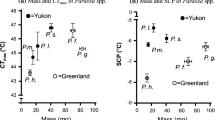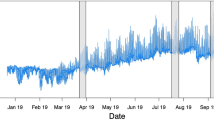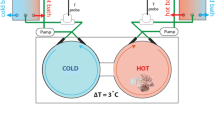Abstract
Despite the relative richness of spider species across the Southern Ocean islands remarkably little information is available on their biology. Here, the critical thermal limits of an indigenous (Myro kerguelenensis, Desidae) and an introduced (Prinerigone vagans, Linyphiidae) spider species from Marion Island were studied after 7–8 days acclimation to 0, 5, 10 and 15°C. Critical thermal minima (CTMin) were low in these species by comparison with other spiders and insects measured to date, and ranged from −6 to −7°C in M. kerguelenensis and from −7 to −8°C in P. vagans. In contrast, critical thermal maxima (CTMax) were similar to other insects on Marion Island (M. kerguelenensis: 35.0–35.6°C; P. vagans: 35.1–36.0°C), although significantly lower than those reported for other spider species in the literature. The magnitude of acclimation responses in CTMax was lower than those in CTMin for both species and this suggests decoupled responses to acclimation. Whilst not conclusive, the results raise several important considerations: that oxygen limitation of thermal tolerance needs to be more widely investigated in terrestrial species, that indigenous and alien species might differ in the nature and extent of their plasticity, and that upper and lower thermal tolerance limits might be decoupled in spiders as is the case in insects.



Similar content being viewed by others
References
Aitchison CW (1984) The phenology of winter-active spiders. J Arachnol 12:249–272
Aitchison CW (1987) Feeding ecology of winter-active spiders. In: Nentwig W (ed) Ecophysiology of Spiders. Springer, Berlin, pp 264–273
Almquist S (1970) Thermal tolerances and preferences of some dune-living spiders. Oikos 21:230–236
Bonan GB (2002) Ecological climatology. Concepts and applications. Cambridge University Press, Cambridge
Burger AE (1978) Terrestrial invertebrates: a food resource for birds at Marion Island. S Afr J Antarct Res 8:87–99
Burger AE (1985) Terrestrial food webs in the sub-Antarctic: island effects. In: Siegfried WR, Condy PR, Laws RM (eds) Antarctic nutrient cycles and food webs. Springer, Berlin, pp 582–591
Chown SL (1993) Desiccation resistance in six sub-Antarctic weevils (Coleoptera: Curculionidae): humidity as an abiotic factor influencing assemblage structure. Funct Ecol 7:318–325
Chown SL (2001) Physiological variation in insects: hierarchical levels and implications. J Insect Physiol 47:649–660
Chown SL, Convey P (2006) Biogeography. In: Huiskes AHL, Bergstrom D, Convey P (eds) Trends in Antarctic terrestrial and limnetic ecosystems. Springer, Berlin, pp 55–69
Chown SL, Convey P (2007) Spatial and temporal variability across life’s hierarchies in the terrestrial Antarctic. Philos Trans R Soc Lond B, In press
Chown SL, Crafford JE (1992) Microhabitat temperatures at Marion Island (46°54′S 37°45′E). S Afr J Antarct Res 22:51–58
Chown SL, Scholtz CH (1989) Biology and ecology of the Dusmoecetes Jeannel (Col. Curculionidae) species complex on Marion Island. Oecologia 80:93–99
Convey P, Chown SL, Wasley J, Bergstrom DM (2006) Life history traits. In: Huiskes AHL, Bergstrom D, Convey P (eds) Trends in Antarctic terrestrial and limnetic ecosystems. Springer, Berlin, pp 101–127
Crafford JE, Scholtz CH (1987) Phenology of stranded kelp degradation by the kelp fly Paractora dreuxi mirabilis (Helcomyzidae) at Marion Island. Polar Biol 7:289–294
Crafford JE, Scholtz CH, Chown SL (1986) The insects of sub-Antarctic Marion and Prince Edward Islands; with a bibliography of entomology of the Kerguelen Biogeographical Province. S Afr J Antarct Res 16:41–84
Daehler CC (2003) Performance comparisons of co-occurring native and alien invasive plants: Implications for conservation and restoration. Ann Rev Ecol Evol Syst 34:183–211
Deere JA, Chown SL (2006) Testing the beneficial acclimation hypothesis and its alternatives for locomotor performance. Am Nat 168:630–644
Deere JA, Sinclair BJ, Marshall DJ, Chown SL (2006) Phenotypic plasticity of thermal tolerances in five oribatid mite species from sub-Antarctic Marion Island. J Insect Physiol 52:693–700
Duncan RP, Blackburn TM, Sol D (2003) The ecology of bird introductions. Ann Rev Ecol Evol Syst 34:71–98
Frenot Y, Chown SL, Whinam J, Selkirk PM, Convey P, Skotnicki M, Bergstrom DM (2005) Biological invasions in the Antarctic: extent, impacts and implications. Biol Rev 80:45–72
Hoffmann AA, Shirriffs J, Scott M (2005) Relative importance of plastic vs genetic factors in adaptive differentiation: geographical variation for stress resistance in Drosophila melanogaster from eastern Australia. Funct Ecol 19:222–227
Huey RB, Hertz PE, Sinervo B (2003) Behavioral drive versus behavioral inertia in evolution: a null model approach. Am Nat 161:357–366
Joly Y, Frenot Y, Vernon P (1987) Environmental modifications of a subantarctic peat- bog by the Wandering Albatross (Diomedea exulans): a preliminary study. Polar Biol 8:61–72
Khoza TT, Dippenaar SM, Dippenaar-Schoeman AS (2005) The biodiversity and species composition of the spider community of Marion Island, a recent survey (Arachnida: Araneae). Koedoe 48:103–107
Klok CJ, Chown SL (1997) Critical thermal limits, temperature tolerance and water balance of a sub-Antarctic caterpillar, Pringleophaga marioni (Lepidoptera: Tineidae). J Insect Physiol 43:685–694
Klok CJ, Chown SL (1998) Interactions between desiccation resistance, host-plant contact and the thermal biology of a leaf-dwelling sub-Antarctic caterpillar, Embryonopsis halticella (Lepidoptera: Yponomeutidae). J Insect Physiol 44:615–628
Klok CJ, Chown SL (2001) Critical thermal limits, temperature tolerance and water balance of a sub-Antarctic kelp fly, Paractora dreuxi (Diptera: Helcomyzidae). J Insect Physiol 47:95–109
Klok CJ, Chown SL (2003) Resistance to temperature extremes in sub-Antarctic weevils: interspecific variation, population differentiation and acclimation. Biol J Linn Soc 78:401–414
Lawrence RF (1971) Araneida. In: van Zinderen Bakker EM, Winterbottom JM, Dyer RA (eds) Marion and Prince Edward Islands. Report on the South African Biological and Geological Expedition 1965–1966. AA Balkema, Cape Town pp 301–313
Ledoux JC (1991) Araignées des îles subantarciques françaises (Crozet et Kerguelen). Rev Arachnol 9:119–164
le Roux PC, McGeoch MA (2007) Changes in climate extremes, variability and signature on sub-Antarctic Marion Island. Climatic Change doi: 10.1007/s10584-007-9259-y
Lutterschmidt WI, Hutchison VH (1997) The critical thermal maximum: data to support the onset of spasms as the definitive end point. Can J Zool 75:1553–1560
Pörtner HO (2001) Climate change and temperature-dependent biogeography: oxygen limitation of thermal tolerance in animals. Naturwissenschaften 88:137–146
Pörtner HO, Knust R (2007) Climate change affects marine fishes through the oxygen limitation of thermal tolerance. Science 315:95–97
Pugh PJA (2004) Biogeography of spiders (Araneae: Arachnida) on the islands of the Southern Ocean. J Nat Hist 38:1461–1487
Schmalhofer VR (1999) Thermal tolerances and preferences of the crab spiders Misumenops asperatus and Misumenoides formosipes (Aranea, Thomisidae). J Arach 27:470–480
Seymour RS, Vinegar A (1973) Thermal relations, water loss and oxygen consumption of a North American tarantula. Comp Biochem Physiol A 44:83–96
Sinclair BJ, Terblanche JS, Scott MB, Blatch GL, Klok CJ, Chown SL (2006) Environmental physiology of three species of Collembola at Cape Hallett, North Victoria Land, Antarctica. J Insect Physiol 52:29–50
Slabber S, Chown SL (2005) Differential responses of thermal tolerance to acclimation in the sub-Antarctic rove beetle Halmaeusa atriceps. Physiol Entomol 30:195–204
Slabber S, Worland MR, Leinaas HP, Chown SL (2007) Acclimation effects on thermal tolerances of springtails from sub-Antarctic Marion Island: indigenous and invasive species. J Insect Physiol 53:113–125
Smith VR (1977) A qualitative description of energy flow and nutrient cycling in the Marion Island terrestrial ecosystem. Polar Record 18:361–370
Smith VR (1987) The environment and biota of Marion Island. S Afr J Sci 83:211–220
Smith VR (2002) Climate change in the sub-Antarctic: an illustration from Marion Island. Clim Change 52:345–357
Smith VR, Steenkamp M, Gremmen NJM (2001) Terrestrial habitats on sub-Antarctic Marion Island: their vegetation, edaphic attributes, distribution and response to climate change. S Afr J Bot 67:641–654
Terblanche JS, Sinclair BJ, Klok CJ, McFarlane ML, Chown SL (2005) The effects of acclimation on thermal tolerance, desiccation resistance and metabolic rate in Chirodica chalcoptera (Coleoptera: Chrysomelidae). J Insect Physiol 51:1013–1023
Terblanche JS, Klok CJ, Krafsur ES, Chown SL (2006) Phenotypic plasticity and geographic variation in thermal tolerance and water loss of the tsetse Glossina pallidipes (Diptera: Glossinidae): implications for distribution modelling. Am J Trop Med Hyg 74:786–794
Vernon P, Vannier G, Tréhen P (1998) A comparative approach to the entomological diversity of polar regions. Acta Oecol 19:303–308
Vogel M (1985) The distribution and ecology of epigeic invertebrates on the sub-Antarctic Island of South Georgia. Spixiana 8:153–163
Acknowledgements
We thank Kamva Qwede and all the members of the 2005 Marion Island relief who assisted with spider collection. We are grateful to Michele Walters for discussion of a previous version of the manuscript, and the referees for their useful and constructive comments. The South African National Antarctic Programme provided logistic support at Marion Island, and the USAID Capacity Building Programme for Climate Change Research provided KRJ with financial support. This is a contribution to the SCAR EBA programme.
Author information
Authors and Affiliations
Corresponding author
Rights and permissions
About this article
Cite this article
Jumbam, K.R., Terblanche, J.S., Deere, J.A. et al. Critical thermal limits and their responses to acclimation in two sub-Antarctic spiders: Myro kerguelenensis and Prinerigone vagans . Polar Biol 31, 215–220 (2008). https://doi.org/10.1007/s00300-007-0349-0
Received:
Revised:
Accepted:
Published:
Issue Date:
DOI: https://doi.org/10.1007/s00300-007-0349-0




